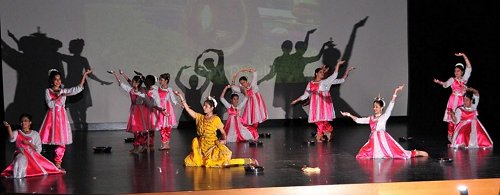 |
 |
Gauri Jog
presents East Meets West
November 12,
2008
The program featured more than 60 dancers and was presented using six major dance forms around the world including Kathak, Mexican, Flamenco, Belly dance, Lavni and Folk dance. There are people who simply have a lot of energy, and the India-born choreographer Gauri Jog is clearly one of them. Since setting up her dance school in Chicago area in 2000, she and her students are performing all over USA with their high energy content driven materials. Recently Gauri Jog also performed at Cities of America pageant in Florida and won 'Modeling and More' championship. In the past we have seen her finest performances, Jhansi Ki Rani (2005) and Fire - Fiery Tale (2007). Based on what we have seen, she truly represents what happens when creativity, handwork and education comes together. As one member of the audience described, "her show is guaranteed not only to lift your spirits, but to stir up the rhythmic pulses deep within your soul." Kathak, a North Indian classical dance form, emphasizes powerful, stamping footwork matched to the complex rhythmic cycles of classical Indian music. But it also demands the nuanced skills of abhinaya, the multitude of facial expressions and finely honed gestures that allow the practitioner to incarnate multiple personalities or creatures in time-honored tales from the great Indian epics like the Mahabharata. Gauri perfected her Kathak dance and teaching techniques at Nagpur, India, where she trained intensively to dance and teach with guru Madan Pande. Her fluid and well-rounded approach to this art form gives her the ability to express herself with creative, original, versatile, and graceful movements.  Gauri Jog, in her solo, performed pure Kathak on taal Dhamar, a cycle of 14 beat taal, giving glimpses of the many intricate aspects and beauty of Kathak - the chaal, the gats, the tihais, the footwork, tatkar. Her subtle expressions and vigorous footwork proved her ability as a versatile Kathak dancer. She started with Amad – entry of a dancer on the stage, Todas – composition of time beats in a rhythmic cycle, Paran – kind of Toda with bols. She portrayed the three important phases of a woman's life. First she displayed Vasaksajja – the state of woman where she adorns herself before meeting her love, Abhisarika – the time in woman's life when she proceeds to meet her love and finally Vatsalya Bhava - motherly love of woman. In the Kathak-Jazz dance we clearly witnessed multiculturalism. The dancers enthralled the audience with complex foot movements, smooth spins and soulful expressions combining beautiful Jazz music with Kathak. The little dancers, who danced to the popular Hindi song "Lakdi Ki Kathi," repeatedly received applause for their performance. Another group of children also performed Kathak based on the 1950 song "Murli Manohar." Dressed in green and colorful costumes, bejeweled with silver ornaments, the dancers with their flawless movements and joyous abundance captivated the audience. We discovered
why each year the popularity of dance programs arranged by Gauri goes up.
The simple answer is variety. This program also featured Belly Dancing
by Jasmin Jahal Dance Company of Chicago, Lavni (a folk dance from India)
by students of Gauri Jog, a Mexican dance by Mexican Dance Ensemble and
fusion of Kathak and Flamenco between Gauri Jog and Michelle Nascimento.
Both Michelle and Gauri danced with often electrifying speed and aplomb.
The creation was a fascinating combination of classicism merging with contemporary,
both styles blending perfectly with each other. Separately, they are superb
performers, but brought together, they were astonishing. Completely at
ease in the other’s company, and full of charm, whether tender, teasing
or squabbling, when they finally came together, they were sublime. It was
not only a beautiful visual experience, but an inspired combination of
poetry, humor, philosophy, and truth. The increasing co-operation between
Indian Dance School and other dance schools across nations gives more opportunities
for students and audience to have exposure to other cultures and traditions.
Another prominent dance from the program to remember was Kathak Yoga. This dance depicted the importance of yoga in Kathak dance and displayed fascinating blend of rhythm and movement. Just as I was admiring its kaleidoscopic changes of pattern, I singled out two dancers moving with especial sweetness and sensuousness in different parts of the stage, only then to recognize them: Alisha Benawra and Isha Jog, among the company's most remarkable principal dancers. Alisha and Isha started the dance with an invitation, the hands extending elegantly out, like a maiden offering a platter. Then their hands turn in and rise up to the sun, spinning around each other like butterflies as they twist and turn in a whirlwind. While its traditions are steeped in indigenous culture of teaching Kathak dance, the influence of modern dance on some of the dances by this school cannot be denied. There was this dance on "Silsila Hai," a popular Bollywood song with very innovative use of expression and dazzling costumes. Perhaps the
most spectacular part of the program came at the end when the group performed
'Deep Nritya' (dance of lights) with lights in their hands and dancing
at times on Thalis (on the rim of a brass plate). This dance was performed
on the occasion of Diwali (festival of lights). At the end, the entire
sequence took on an intimate, dreamlike quality as Gauri bent gently on
the floor to pick up a handkerchief lying on the floor with 'Samai' (a
traditional Indian metallic lamp) on her head and other lamps in her hands.
It was a moment of true beauty. Back in India, Samai dance is performed
by very skilled dancers since it involves lot of balancing skills and concentration.
|